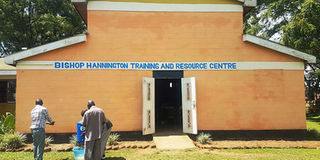Anglican church with roots to bishop James Hannington

Bishop Hannington Center is one of the income generating projects started by the Mumias Diocese. PHOTO | SHABAN MAKOKHA | NATION MEDIA GROUP
What you need to know:
- Bishop James Hannington was the first bishop of the Anglican Church of the Eastern Equatorial Africa Diocese.
- The site of Hannington's monument attracts tourists, students, historians and researchers searching for information about the bishop
The Anglican Church of Kenya (ACK), Mumias Diocese, traces its roots to the 17th century during the era of Nabongo Mumia, King of Wanga Kingdom.
The church’s history is decorated with royalty, selfless sacrifice, community workmanship and early Christian evangelism.
When the Church Missionary Society (CMS) entered the region in the 17th century, it cultivated a cordial relationship with Mumia who was Muslim. He donated 42 acres of land to the church in 1885.
Swahili traders had been in the region earlier, paid homage to the king and converted him to Islam.
When Bishop James Hannington, who was the first bishop of the Anglican Church of the Eastern Equatorial Africa Diocese, went to Mumias in 1885 Mumia welcomed him.
ARREST
Hannington was on his way to Uganda for his missionary work.
Bishop John Wandera said that Mumia warned him against approaching Buganda from the East because locals considered guests from that direction bad people who would bring down their kingdom.
“He despised the warning, telling Mumia that the British government would protect him against attacks by enemy tribes. He was arrested on arrival in Busoga, alongside the 50 potters that Mumia had given him, on orders from King Mwanga 11 of Buganda Kingdom,” said Bishop Wandera.
The unexpected intrusion of German imperialists at the coast had made the Buganda king suspicious of Hannington’s motives.
An oracle had said that Buganda’s conqueror would come from the east.
DEATH
After eight days of captivity, Hannington’s porters were killed by order of Mwanga II.
And on October 29, 1885, Hannington was speared to death. However, some members of his caravan, including Otsialo Lukuku, escaped and hid in the home of a Busoga woman for three years.
According to Mr Francis Lutomia, a church elder, when Mumia learnt that the bishop had been killed ,he organised for his body to be transported and buried in Mumias.
But Mwanga II became hostile to his emissaries and the plan was abandoned.
Some claim that a famine broke out in Buganda for the three years that Otsialo was in the land.
“Elders got concerned and sought to find out the reason from fortune-tellers who told them that the famine was caused by the white man’s bones. They decided to take back the bones but they didn’t know where he came from,” Mr Lutomia said.
They went for Otsialo and gave him the bones to take back to where the missionary had come from.
ENCROACHMENT
The bones were buried at Mwilala wa Shiundu (King Shiundu’s bunker), where they rested until the British exhumed the remains in 1890 and took them to his home in Sussex, England, for final interment.
The land donated to the church later became a tug-of-war between the church, private investors and the local authority.
“Today, the County Government of Kakamega is putting up a level four hospital on part of the land. We have remained with only 12 acres following encroachment by both the government and private investors,” said Mr Michael Washika, the finance officer.
Today, Hannington’s monument stands at a corner of Nabongo Sports Ground, on the grounds of ACK Bishop Hannington Cathedral Church, a kilometre away from Mumias town.
EDUCATION
The sports ground serves as a football pitch, animal grazing field and venue for public events.
“We put up the monument because of the respect that the ACK has for Bishop Hannington as the person who started Anglicanism in this region,” said Mr Washika.
The site attracts tourists, students, historians and researchers searching for information about Bishop Hannington.
The Diocese of Mumias was curved out from the Diocese of Maseno North in January 1993.
Today it sponsors 62 primary schools, three polytechnics, 42 secondary schools, 182 ECDE centres and a teachers training college named after the bishop.
Is there a site you want us to feature? Write an e-mail to [email protected]





